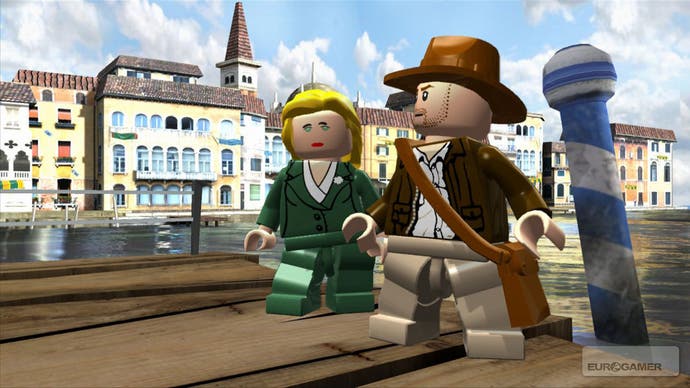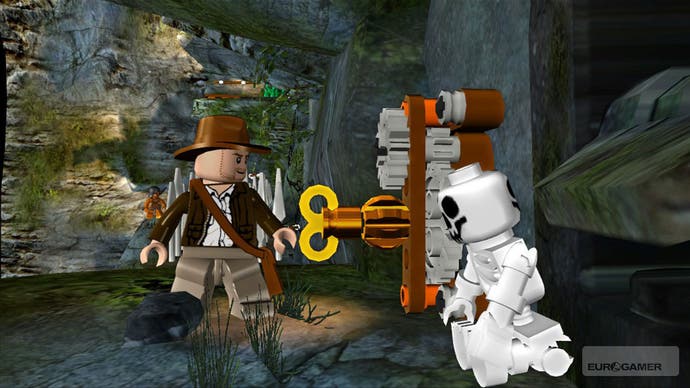LEGO Indiana Jones: The Original Adventures
Bricking it.
The words "game design" tend to get bandied about rather a lot, but usually when people talk about game design what they actually mean is level design. While there's certainly an art to crafting a level in such a way that players are challenged, encouraged and thrilled in an agreeable ratio, the skill that goes into creating the overall experience outside of the actual gameplay is less understood. I'm talking about overall structure, pace and reward - that arcane art of understanding the audience, delivering the right encouragement at just the right time and still managing to offer up delights and surprises along the way.
These are qualities that the LEGO Star Wars games have in abundance. Yes, they're cute and funny and amusing to play, but in terms of general construction they're also some of the best-designed kid's games since...well, since forever. They're that good. The drop-in multiplayer. The ability to go back and replay any level at any time. The myriad quirky details buried in every corner. You only have to watch children playing the games, excitedly discovering all the little nooks and crannies, to realise that Traveller's Tales went to extraordinary lengths to create a game that was accessible to the youngest newcomer and yet still offered fresh thrills and rewards once their skill had matured. That, you see, is true game design at work.

All of which acts as both a blessing and a curse for LEGO Indiana Jones. It has a tried and trusted gameplay system to build on (no pun intended, honest) but it also has a lot of expectation to live up to. The good news is that the gameplay is both comfortingly familiar and suitably evolved. The Indiana Jones movies are rather light on aliens, robots and magic space monks so the template of using certain character types to access specific areas has had to change, and it's a change for the better. Indy's all-human cast now enjoys a more democratic gameplay design, with the most common abilities available to all - provided you can find the right tool for the job. You can now pick up a shovel, or a spanner, or even a weapon and keep it with you as you explore. Pistols, machineguns and bazookas can be swiped from enemies and tucked away for later. Swords and spears can be wielded in combat, or thrown to cut important ropes or chains. There are still some elements that are restricted - the handful of women can jump higher than blokes and you still need an enemy uniform to open certain areas - but for the most part progress is now dictated by items rather than characters.
Whereas puzzles in LEGO Star Wars tended to be a simple matter of using the right character to reach a switch, this is a much more involved adventure. For example, you might use a shovel to dig an item out of the ground and discover that it's a cog needed to operate the machine that in turn opens the gate to the next area. Except once the cog is replaced you might then need to find a spanner to actually fix the mechanism. But the spanner is in the hands of a cheeky monkey up on an unreachable ledge, so you need to find a banana and throw it to him in exchange for what you need. Okay, for us grown-up players it's a fairly obvious series of miniature fetch-quests, but for the intended young audience it's smartly paced and encourages plenty of lateral thinking. There's room for free thinking, but everything is constrained by logical parameters that prevent things getting frustrating.

Also new is the ability to swing and climb on ropes, and while the physics isn't exactly cutting edge it's a perfect fit with the Indy series and adds another fun element to the level designs. Each movie is, as with Star Wars, divided up into six levels with the first generally being easier (in case someone opts not to play the movies in linear order) with the last being tougher. Tough is relative, of course, but there were more levels that had me scratching my head here than in LEGO Star Wars. Progress is less linear, while the ability to pick up and carry items means that objectives can now be scattered around a larger playing area, forcing you to explore your surroundings more thoroughly. Teamwork is also more important, with more puzzles that require one character to help the other past hazards. The AI on the non-player characters isn't always great in this regard, sometimes getting in your way or wandering out of range, but the fantastic drop-in gameplay means that parents can easily offer as much assistance as is required to get things back on track.








